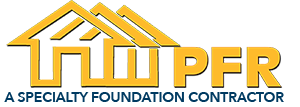Leveling
Work with Charlotte’s #1 rated Foundation Repair Specialist that is focused on raving fan customer service.
- HOME
- LEVELING
We know the importance of a leveled home or structure. For example, if your chimney is pulling away from your house, it’s a serious issue that needs immediate attention. Here’s some information on the potential causes, whom to contact, and potential remedies:
Why is the chimney pulling away?
Foundation Settlement: If your home’s foundation settles unevenly, it can cause the chimney to pull away from the house. This is particularly common in areas with expansive clay soils that expand and contract based on moisture levels.
Improper Construction: If the chimney was not properly tied into the house during construction or lacked an adequate footing, it might gradually lean or pull away from the house over time.
Root Interference: Trees growing close to the chimney can have roots that push against the chimney foundation, causing movement.
Freeze/Thaw Cycles: In colder climates, water can enter cracks in the masonry, freeze, expand, and then cause the masonry to crack or shift.
Water Damage: Water can seep into the bricks and mortar, weakening them over time. This is especially true if there are cracks in the chimney crown or if the flashing isn’t properly sealed.
Other Factors: Earthquakes, significant wind events, or other factors can lead to structural issues with your chimney.
Who do you call?
Masonry Specialist or Chimney Repair Contractor: Look for contractors who specialize in chimney or masonry repair. They will have the knowledge and equipment to safely assess and repair your chimney.
Structural Engineer: If you’re unsure about the severity of the issue or if you believe it’s related to a larger foundational problem, you might consider hiring a structural engineer to evaluate the situation.
How is it fixable? What techniques?
Chimney Bracing: If the chimney is slightly leaning or unstable, it might be possible to brace it using steel brackets to hold it in place.
Foundation Underpinning: If foundation settlement is the issue, underpinning the chimney can stabilize it. This involves extending the foundation to a more stable layer of soil or bedrock.
Partial or Full Rebuild: In some cases, the best or only option might be to partially or fully rebuild the chimney. This can ensure that it’s properly anchored to the house.
Tuckpointing: This is a process of removing deteriorated mortar from the joints of a brick structure and replacing it with new mortar. This can be essential if water damage or freeze/thaw cycles have eroded the mortar.
Waterproofing: After repairs, consider waterproofing the chimney to prevent water intrusion, which can lead to further damage.
Install Proper Flashing: If the issue is related to poor flashing, get it replaced and properly sealed.
House Leveling?
There are several signs that your house needs leveling, including:
Sloping or uneven floors: If you notice that your floors are sloping or uneven, it could be a sign that your foundation is settling or shifting.
Stuck windows and doors: If your windows and doors are sticking or difficult to open and close, it could be a sign that your foundation is shifting and causing the frames to warp.
Cracks in walls and ceilings: If you notice cracks in your walls or ceilings, it could be a sign that your foundation is settling or shifting.
Leaning or unstable chimney: If your chimney is leaning or appears to be unstable, it could be a sign that your foundation is shifting and causing the chimney to move.
Unlevel mortar joints: If you notice that the mortar joints in your brick or stone walls are unlevel, it could be a sign that your foundation is settling or shifting.
It’s important to address these signs of foundation issues as soon as possible to prevent further damage to your home. House leveling can be a technical and complex process, and it’s best to leave it to the experts like Chris at Piedmont Foundation Repair. The cost of leveling a house can vary widely depending on the extent of the damage, the size of the house, and the technique used. The average cost to level a house is $3,500 to $10,000
To level a house with sloping floor, there are several techniques available, including:
- Pier and beam repair: This involves installing concrete piers or steel pilings under the foundation to provide additional support and lift the foundation back to its original level. The cost of pier and beam repair can vary widely depending on the extent of the damage and the size of the house, but it typically ranges from $3,500 to $6,500 for a single corner and up to $20,000 for extensive damage.
- Slab leveling: This technique is used for houses with a concrete slab foundation. It involves injecting a special foam material under the slab to lift it back to its original level. The cost of slab leveling usually averages around $500 to $1,500, but it depends on the size of the area to level the materials used and the labor.
- House lifting: This technique is used when the foundation is severely damaged or when the homeowner wants to add a basement. It involves lifting the entire house off its foundation and installing a new foundation or basement. The cost of house lifting can range from $10,000 to $40,000 for raising the house only, and up to $150,000 for adding a basement.
- Cost: The cost of leveling a house can vary widely depending on the extent of the damage, the size of the house, and the technique used. The average cost to level a house is $3,500 to $10,000.
- The cost of excavation, structural engineering, and other related expenses can add to the total cost.
- Time: The time it takes to level a house can also vary depending on the extent of the damage and the technique used. A typical residential foundation repair takes two to three days.
- However, more extensive repairs or house lifting can take several weeks or even months to complete.
What are the consequences of not leveling a house on time?
Not leveling a house on time can have several consequences, including:
- Severe foundation damage: If left unaddressed, foundation issues can lead to extensive deterioration of the foundation, which can cause further damage to walls, flooring, and ceiling. It can also lead to warping of the structure
- Plumbing issues: Leveling can place plumbing at risk for separation during the raising process, which can lead to leaks and pipe bursts
- Structural integrity issues: Sloping floors can damage the structural integrity of the home, which can lead to further damage if not addressed
- Increased repair costs: Waiting to level a house can cause the price of the project to rise because of material and labor costs go up
- Cosmetic and functional issues: Unleveled floors can cause cosmetic and functional issues, such as drywall cracks and sticky frames.
It’s important to address foundation issues as soon as possible to prevent further damage to your home and avoid costly repairs.
Why worry? Give us a call at 704-401-4111 and schedule a FREE problem assessment. With over 30 years of experience, he can let you know if you have a serious problem and if you do, how to get it resolved.


